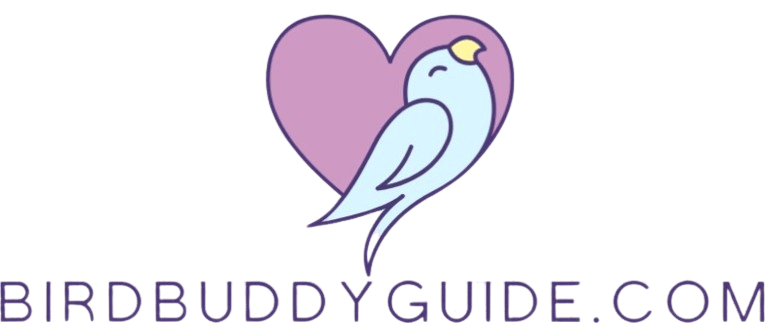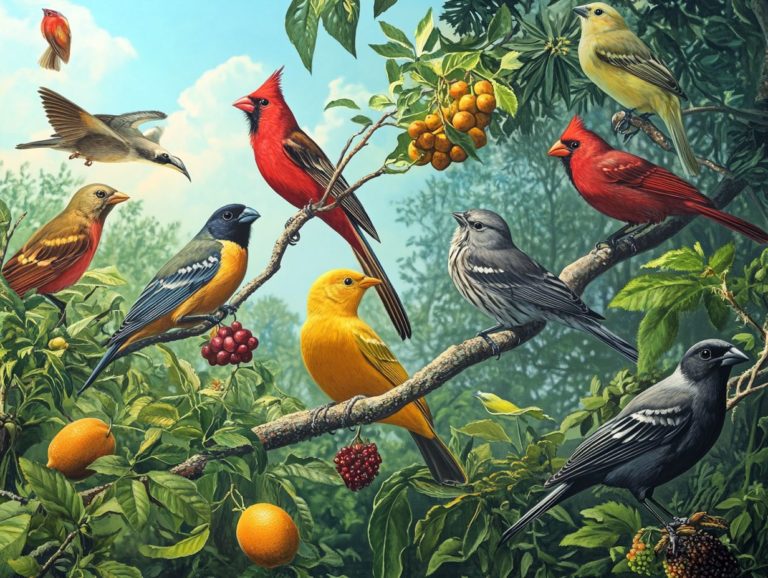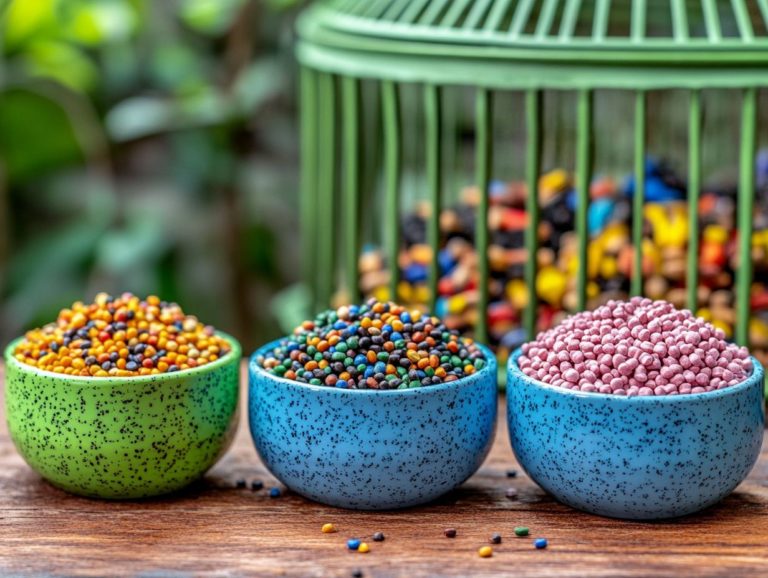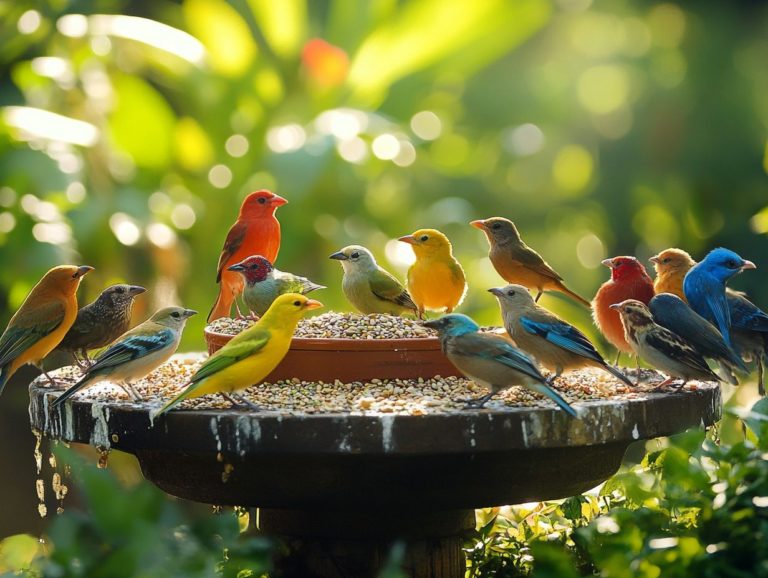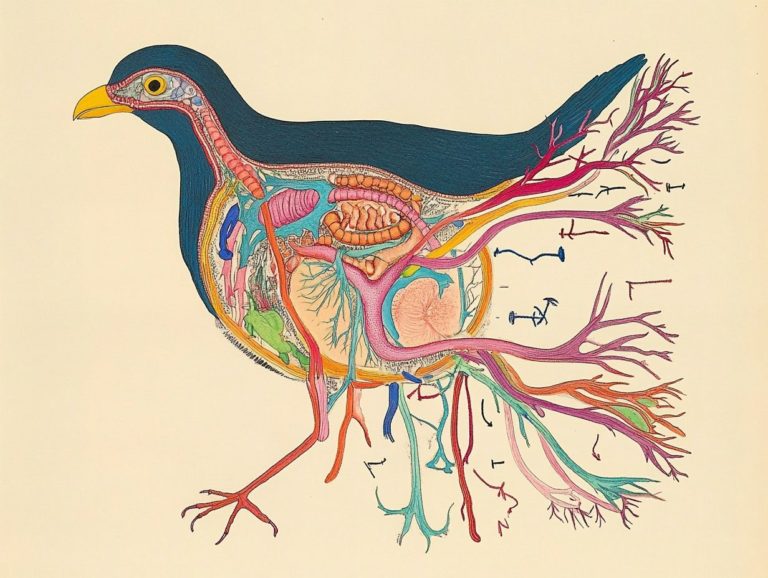5 Creative Ways to Feed Your Bird
Birds are not merely beautiful companions; they flourish with stimulation and variety in their diets.
If you re seeking fresh ideas to keep your feathered friend both happy and healthy, this article offers a wealth of creative approaches to elevate their feeding routine.
From crafting a homemade bird feeder to integrating puzzle toys and foraging stations, you ll discover how to provide a balanced diet that nurtures both their physical and mental well-being.
Get ready to turn mealtime into an adventure for your feathered friend!
Contents
- Key Takeaways:
- 1. Make a Homemade Bird Feeder
- 2. Create a Foraging Station
- 3. Offer a Variety of Fresh Foods
- 4. Use Puzzle Toys for Mental Stimulation
- 5. Incorporate Treats into Training Sessions
- Why Is It Important to Provide a Variety of Foods for Birds?
- Frequently Asked Questions
- What are 5 creative ways to feed your bird?
- How can I make foraging more exciting for my bird?
- What are some safe ingredients for homemade bird treats?
- Why is it important to offer a variety of fresh produce to my bird?
- Can I use regular toys as puzzle feeders for my bird?
- Are there any precautions I should take when offering homemade bird treats?
Key Takeaways:
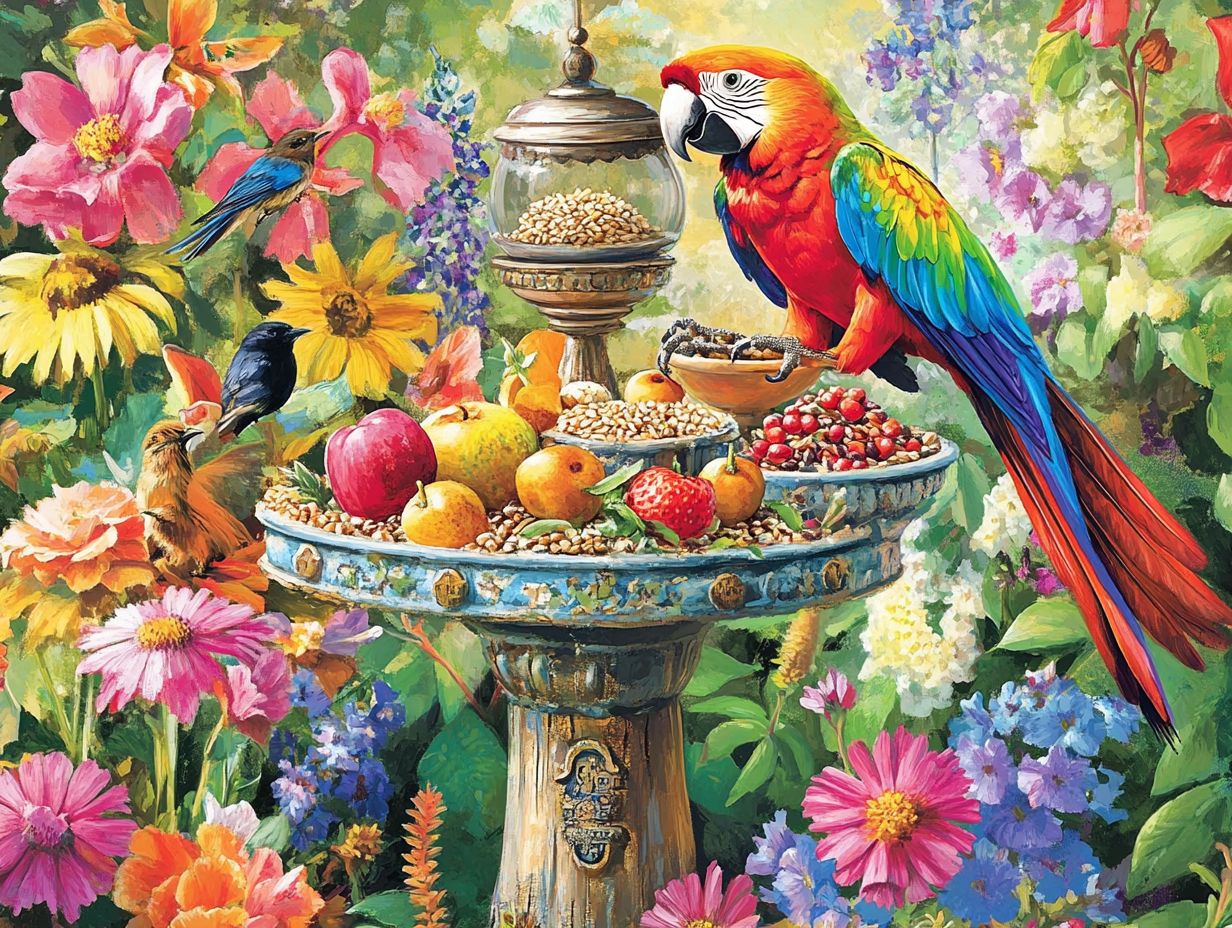
- Get creative with a homemade bird feeder using household materials like pine cones and peanut butter. Consider making bird feeder muffins for a fun treat!
- Stimulate your bird’s foraging instincts with a designated foraging station filled with different treats and toys.
- Offer a variety of fresh, nutritious foods to provide a well-rounded diet for your feathered friend.
1. Make a Homemade Bird Feeder
Creating a DIY bird feeder is a delightful project that not only enhances your backyard’s charm but also provides essential nutrition for a variety of bird species, such as woodpeckers, nuthatches, and bluebirds. This is especially valuable during winter months when food is scarce.
Explore different types of homemade feeders tube, platform, or suet. Tube feeders are perfect for holding sunflower seeds, making them a magnet for finches and chickadees.
A simple wooden platform feeder can attract ground-feeding birds like sparrows and juncos. Suet feeders, often designed with a mesh or cage, offer energy-rich suet cakes (animal fat cakes) that woodpeckers can t resist.
When constructing these feeders, opt for eco-friendly materials like reclaimed wood or recycled plastic to promote sustainability and enrich your garden’s ecosystem.
A straightforward recipe for attracting birds involves filling your chosen feeder with sunflower seeds and hanging it in a spot where you can easily view it from your window, making birdwatching an engaging and enjoyable activity.
2. Create a Foraging Station
Establishing a foraging station in your backyard transforms it into a natural bird sanctuary. This invites ground-feeding birds like sparrows and juncos to indulge in a delightful assortment of foods, such as millet and cracked corn.
To maximize your station’s effectiveness, place it in a sheltered spot, away from fierce winds and heavy foot traffic. Ideally, position it beneath trees or shrubs for cover.
Provide a variety of feeding options, including sunflower seeds, peanuts, and dried fruits, to entice a range of bird species and create a gourmet menu featuring 5 yummy treats birds can’t resist that enriches their daily diet.
This strategy mimics how birds naturally forage, making your backyard an exciting place for them to explore! The greater the variety you offer, the more irresistible your foraging station becomes, encouraging delightful interactions among different bird species.
3. Offer a Variety of Fresh Foods
Providing a variety of fresh foods is essential for attracting and sustaining bird populations. Options like peanut butter, dried fruits, and even raisins or currants can create a nutritious menu for your feathered friends while promoting biodiversity in your backyard.
Incorporating seeds, grains, and suet can significantly enhance their nutrition, catering to the diverse needs of various species. For instance, sunflower seeds are a favorite among finches and chickadees due to their energy-rich content, while mealworms are a delightful treat for insectivorous birds like bluebirds and wrens.
By offering these foods, you can positively influence their foraging behaviors, resulting in increased activity and visibility in your garden. To elevate this outdoor dining experience, consider planting bird-friendly flowers such as coneflowers and black-eyed Susans. These not only attract birds but also beneficial insects, creating a vibrant ecosystem right in your backyard.
4. Use Puzzle Toys for Mental Stimulation
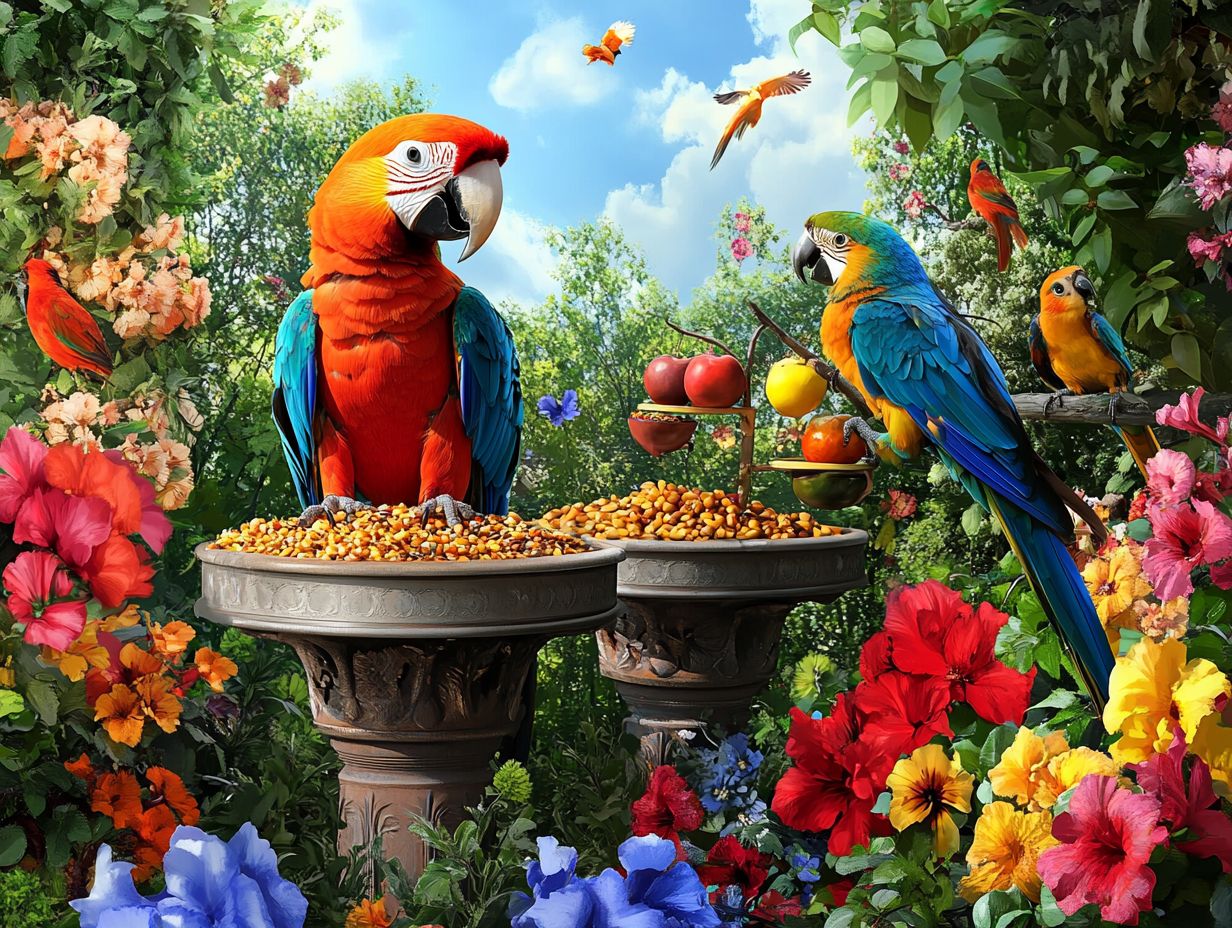
Incorporating puzzle toys into your bird feeding routine does more than just encourage effective feeding habits; it also provides important brain exercise, helping birds behave better while adding an element of fun for bird enthusiasts of all ages.
These ingenious toys mimic foraging in nature, inviting your birds to engage their instincts as they peck, pry, and work for their food. For instance, puzzle feeders that dispense seeds or treats when manipulated can inspire your feathered companions to tackle challenges. Additionally, learning 5 ways to build trust with your bird can significantly enhance their thinking abilities and help them solve problems.
When you pair these puzzle feeders with creative designs that require effort to access food, you transform the overall feeding experience into a dynamically adventurous activity. You’ll be amazed to see noticeable improvements in mental health, as these interactive toys encourage problem-solving and physical activity crucial elements for a happy, thriving avian life.
5. Incorporate Treats into Training Sessions
Adding treats like sunflower seeds and other safe foods to your training sessions can significantly enhance your bonding experience with your birds. For some fun ideas, check out these easy recipes for homemade bird treats, ensuring they enjoy a nutritious diet free from potential hazards like outdoor cats.
By utilizing homemade nectar as a special reward, you can present a delightful array of flavors that birds find irresistible. This not only elevates motivation during training but also allows you to control the ingredients, ensuring everything remains safe and healthful.
To minimize distractions during feeding and training sessions, create an environment that reduces risks. This could involve setting up a designated training area away from windows or installing outdoor barriers to keep curious felines at bay.
With consistent practice and the right treats, you ll cultivate a trusting and responsive relationship with your feathered companions.
Why Is It Important to Provide a Variety of Foods for Birds?
Providing a variety of foods for birds is essential for their health and well-being. It allows them to maintain a balanced diet that supports their diverse nutritional needs while reducing the risks of issues such as ground collisions, particularly during the winter months when food is scarce.
Different bird species thrive on specific nutrients, so offering a range of seeds, fruits, and insects caters to their individual preferences. For instance, while some birds may gravitate towards high-energy seeds, others might thrive on the protein found in mealworms. Varying food options enrich their diet and encourage healthier behaviors, as birds engage in natural foraging activities.
Food scarcity can lead to increased competition and stress among birds. This makes it crucial for backyard enthusiasts and conservationists like you to provide sufficient and diverse offerings. By doing so, you can mitigate these challenges and contribute to a thriving bird population in your local ecosystems.
What Are Some Safe and Healthy Foods for Birds?
Safe and healthy foods for your feathered friends include a delightful array of options like sunflower seeds, peanut butter, and suet. These not only deliver essential nutrients but also entice a variety of species to your bird feeders.
Beyond these beloved staples, think about incorporating millet, safflower seeds, fresh fruits, and mealworms into their diet. Each of these choices significantly enhances the nutritional profile, offering unique benefits.
For instance, the high fat content in suet provides much-needed energy during the chillier months, while mealworms supply essential protein for nesting birds.
To prepare and present these foods effectively, consider using specialized feeders designed to minimize waste and spoilage, ensuring the offerings remain fresh. For a more engaging experience, try fun activities to enjoy with your adopted bird, like arranging fruits artistically or spreading a peanut butter mix on tree bark, which can attract a diverse range of birds and transform your backyard into a vibrant aviary while prioritizing their health and well-being.
How Can Foraging Benefit a Bird’s Physical and Mental Health?
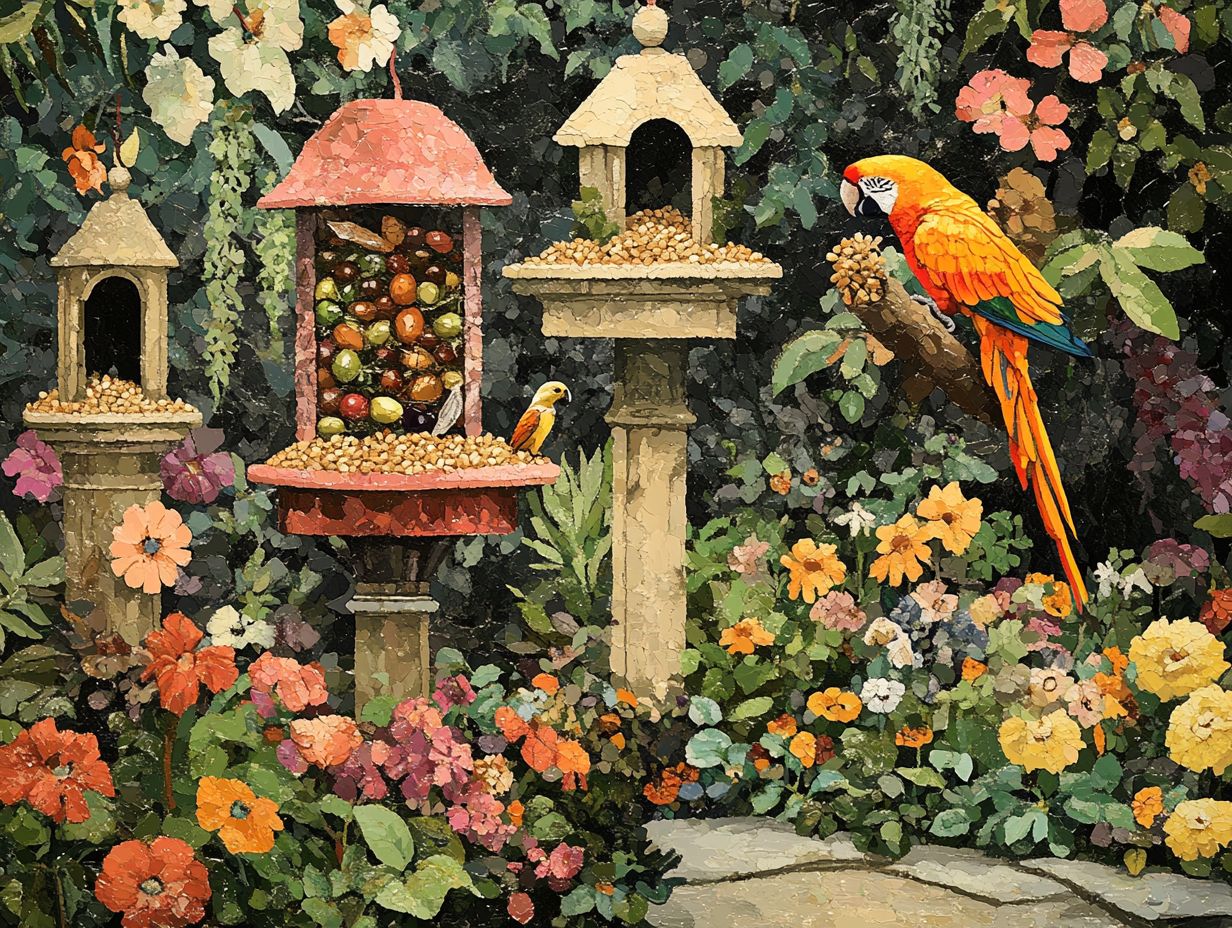
Foraging offers tremendous benefits to a bird’s physical and mental health. It encourages natural behaviors, supports exercise, and alleviates stress especially vital for ground-feeding birds like sparrows and juncos that flourish in their natural environments.
These foraging activities replicate instinctual survival behaviors. They enable birds to build muscle strength and maintain agility. In this dynamic process, the bird stirs the ground in search of seeds or insects. This leads to enhanced physical well-being and improved thinking skills.
The mental engagement involved in foraging fosters a sense of purpose. This effectively reduces anxiety and boosts confidence. Take social birds like sparrows; their communal foraging habits strengthen social bonds, creating a support system that diminishes stress and promotes overall well-being.
Just as these avian creatures find nourishment in their natural habitats, you too can reap the rewards of nature’s bounty. You can reinforce your mental resilience through similar immersive experiences.
What Types of Puzzle Toys Are Suitable for Birds?
Puzzle toys serve as an exceptional means to promote mental stimulation for your avian companions. They offer a remarkable variety in design.
You’ll find options such as foraging puzzles and treat-dispensing toys, as well as top 10 creative bird toy ideas you can make. These are particularly well-suited for a range of bird species.
These toys can elevate standard bird feeders or foraging stations into dynamically play areas that truly challenge your bird’s problem-solving skills. Imagine a fun foraging puzzle for parakeets that requires them to slide panels to discover hidden treats. It s a game they ll love!
Meanwhile, a treat-dispensing toy designed for larger parrots may involve manipulating levers or rotating sections to access their favorite seeds. It s essential to choose these puzzle toys with your bird’s specific needs in mind.
Smaller birds thrive with simpler designs, while larger birds benefit from more intricate challenges. By thoughtfully incorporating these engaging toys into their environment, you can significantly enhance your feathered friends’ cognitive development and overall well-being.
How Can Training Sessions Help Bond with Your Bird?
Training sessions can become a remarkable opportunity for you to strengthen the bond with your bird. Turn feeding time into engaging activities that foster trust and communication between you and your feathered companion.
Whether you re teaching simple tricks or encouraging your bird to vocalize, employing the right techniques can truly make a world of difference. Incorporating positive reinforcement, such as treats or verbal praise, not only reinforces good behavior but also deepens your connection.
Creating a safe training environment is essential. Ensure the space is free from hazards and provides comfort for your bird.
To minimize distractions, consider using a quiet room, especially if there are outdoor cats or other pets around. A covered cage nearby or some curtains can help maintain focus, allowing your bird to thrive during your interactions.
What Are Some Other Creative Ways to Feed Birds?
Exploring creative ways to keep your bird engaged, like whipping up bird feeder muffins and crafting birdseed wreaths, can transform your backyard into an inviting haven for various species. This elevates your overall birding experience.
These inventive feeding methods deliver essential nutrition for birds while enhancing the visual appeal of your outdoor landscape. For example, consider using top 10 bird enrichment ideas for happy pets like bird feeder muffins made from a delightful blend of birdseed, peanut butter, and flour, baked in muffin tins, then hung from trees or feeders.
And let s not forget the charm of birdseed wreaths. These are crafted using a gelatin mixture and an assortment of seeds, serving as a stunning focal point that attracts your feathered friends.
By implementing these creative ideas, you can seamlessly blend aesthetics with functionality. Ensure that your environment is both pleasing to the eye and beneficial for your avian visitors by following 5 quick tips for feeding your bird.
Frequently Asked Questions
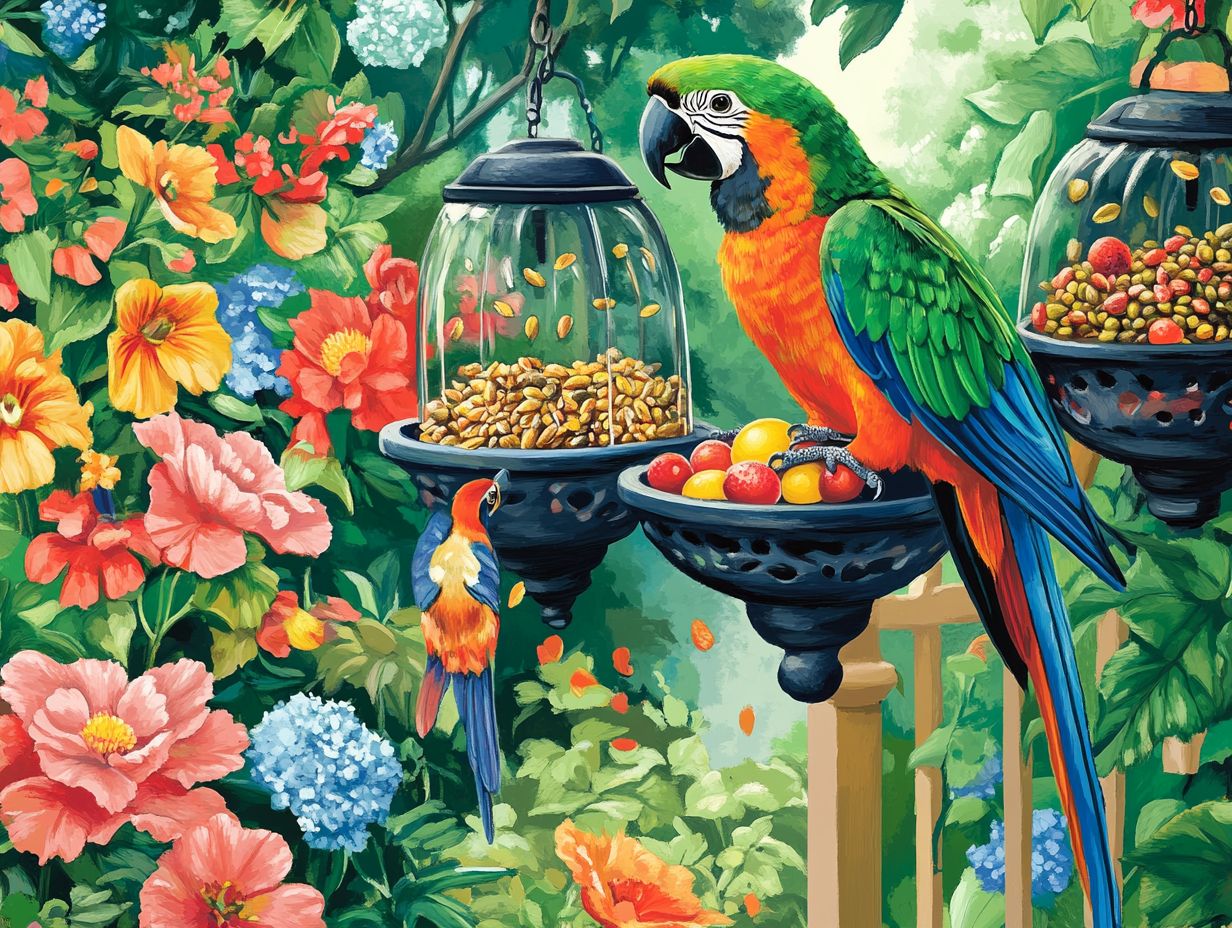
What are 5 creative ways to feed your bird?
1. Create a foraging station. Hide treats and pellets around your bird’s cage or play area.
2. Make homemade bird treats. Use bird-safe ingredients like fruits and veggies.
3. Offer a variety of fresh produce. Include leafy greens and colorful fruits.
4. Use puzzle feeders or toys. These require your bird to work for their food.
5. Make a bird-friendly snack mix. Combine different bird-safe seeds, nuts, and dried fruits.
How can I make foraging more exciting for my bird?
Rotate the location of treats and use different types of foraging toys. Make it more challenging by adding obstacles or changing the difficulty level of the toys.
What are some safe ingredients for homemade bird treats?
Fruits and vegetables are great options. Just ensure they are safe for your specific type of bird.
Other safe ingredients include seeds, nuts, and grains.
Why is it important to offer a variety of fresh produce to my bird?
Variety ensures a well-rounded and nutritious diet. Different fruits and vegetables offer different vitamins and minerals.
Can I use regular toys as puzzle feeders for my bird?
No. Choose toys made just for birds! They re safe and designed for fun. Regular toys might have small parts that can be harmful if ingested.
They may also not be durable for your bird’s beak.
Are there any precautions I should take when offering homemade bird treats?
Yes. Only use bird-safe ingredients. Avoid anything that could be toxic to your bird.
Always consult with a veterinarian before introducing new foods to your bird’s diet.
